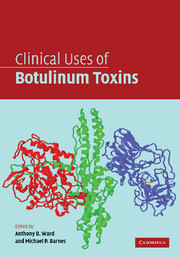Book contents
- Frontmatter
- Contents
- List of Contributors
- 1 Introduction
- 2 Mechanistic basis for the therapeutic effectiveness of botulinum toxin A on over-active cholinergic nerves
- 3 Botulinum toxin: from menace to medicine
- 4 Botulinum toxin: primary and secondary resistance
- 5 Introduction to botulinum toxin in clinical practice
- 6 Cervical dystonia
- 7 The use of botulinum toxin in otolaryngology
- 8 Spasticity
- 9 Hyperhidrosis
- 10 Hypersalivation
- 11 Botulinum toxin type A for the prophylactic treatment of primary headache disorders
- 12 Botulinum toxin in the management of back and neck pain
- 13 Clinical uses of botulinum toxin
- 14 Bladder and bowel indications
- 15 Cosmetic uses of botulinum toxin A
- 16 Other clinical neurological uses of botulinum toxin
- Index
- Plate section
- References
10 - Hypersalivation
Published online by Cambridge University Press: 02 December 2009
- Frontmatter
- Contents
- List of Contributors
- 1 Introduction
- 2 Mechanistic basis for the therapeutic effectiveness of botulinum toxin A on over-active cholinergic nerves
- 3 Botulinum toxin: from menace to medicine
- 4 Botulinum toxin: primary and secondary resistance
- 5 Introduction to botulinum toxin in clinical practice
- 6 Cervical dystonia
- 7 The use of botulinum toxin in otolaryngology
- 8 Spasticity
- 9 Hyperhidrosis
- 10 Hypersalivation
- 11 Botulinum toxin type A for the prophylactic treatment of primary headache disorders
- 12 Botulinum toxin in the management of back and neck pain
- 13 Clinical uses of botulinum toxin
- 14 Bladder and bowel indications
- 15 Cosmetic uses of botulinum toxin A
- 16 Other clinical neurological uses of botulinum toxin
- Index
- Plate section
- References
Summary
Introduction
The terms drooling, hypersalivation and sialorrhoea have been used interchangeably in scientific jargon. Drooling and sialorrhoea can be considered as synonymous, both indicating ‘unintentional loss of saliva from the mouth’, perhaps being more profuse in drooling. They usually refer to difficulty in swallowing, either because of pharyngeal muscle weakness, or of reduced spontaneous swallowing or incoordination, leading to excessive pooling of saliva in the anterior mouth and consequent spillage. Hypersalivation (or absolute hypersalivation) is an ‘abnormally increased production of saliva’, and does not necessarily lead to drooling, if swallowing is efficient. Drooling is sometimes simply referred to as ‘relative hypersalivation’.
Background and clinical description
Saliva performs a number of functions: it facilitates swallowing, keeps the mouth moist and teeth clean, conveys molecules to stimulate the taste, and has digestive and antibacterial functions. Normal daily salivary production is about 1–2 l (0.5–1.5 ml / min). The majority of daily salivary production is secreted by the parotid and submandibular glands; the parotids account for about 20 per cent of all saliva production, whilst the submandibular glands produce about 70 per cent (Table 10.1). Sympathetic impulses modulate the output of preformed components, including amylase and lysozyme, from salivary cells.
The swallowing reflex normally prevents drooling. Swallowing is a complex task requiring intact neuromuscular coordination: the mean number of swallowing actions per hour is 25.
- Type
- Chapter
- Information
- Clinical Uses of Botulinum Toxins , pp. 201 - 228Publisher: Cambridge University PressPrint publication year: 2007

